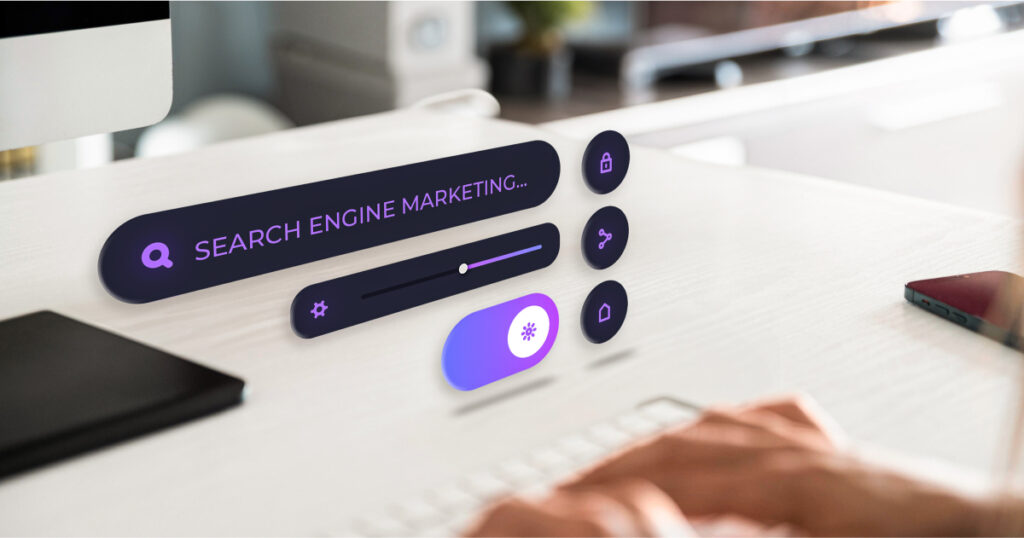Download Our Guide to Explore AI-driven SEO Tools & Tips
Do you rely on Search Engine Optimization (SEO) to draw and convert traffic to your website?
Then, you must know that AI and SEO are now closely intertwined, transforming modern strategies., voice assistants, and mobile-first experiences.
Advanced SEO techniques, often implemented by a top-notch SEO Agency leverage artificial intelligence to analyze data, predict trends, and fine-tune content.
Additionally, integrating voice assistants and focusing on mobile-first experiences are becoming essential for staying ahead in the evolving SEO landscape.
AI’s Impact on SEO
According to a survey by Forbes Advisor, businesses actively incorporate AI into different management aspects – 52% employ AI in SEO.
As the virtual landscape evolves, so does how users search, find information, and engage with content.
AI has become the driving force behind these changes, revolutionizing how search engines operate and businesses optimize their online presence.
In this blog, we’ll dive deep into the evolution of SEO, exploring the game-changing impact of AI in SEO and uncovering key trends boosting the visibility of your website.
Revolutionizing Search: Voice and Mobile

In search, two players are taking center stage: Voice and Mobile.
Let’s dive deeper.
Voice Search
Voice search is rapidly evolving, and it’s a game-changer. With more users employing voice-activated gadgets to browse, voice SEO (VSEO) is now a big deal in the SEO world.
AI and SEO are playing crucial roles here. For instance, natural language processing SEO helps optimize content to match the way people naturally speak and ask questions.
According to Statista, soon, there will be 8.4 billion voice assistants globally – more than the world’s population!
Most voice searches are questions, so to rock VSEO, start by answering those questions.
That’s where AI SEO tools come in handy. They reveal the questions people ask, and you build content around them.
Remember that VSEO is super competitive because voice assistants only pick the top answer from the search results.
To win at VSEO, you’ve got to know all the SEO tricks to grab that top spot!
Mobile-First, SEO Success
SEO strategies are adapting to keep up with the fast-paced world of mobile devices and the changing landscape of online searches.
SEO mobile optimization is your shining compass.
Here’s why:
- Google loves mobile-friendly sites: Google boosts mobile-optimized sites to the top of search results. Clunky, desktop-only sites get ignored and forgotten.
- People love websites that work on their phones: We’re all phone addicts nowadays, searching on the move. If your site takes forever to load, throws errors, or makes users zoom, they’ll ditch you faster than a bad Wi-Fi connection.
- Mobile converts better: A smooth, user-friendly mobile experience builds trust. Users feel like they’ve found a hidden gem. They’re more likely to stick around, explore, and maybe even purchase – the ultimate SEO gold mine.
Fine-Tuning SEO Strategies

It’s time to fine-tune your SEO strategy with some cutting-edge tools.
Google’s Passages Feature: Instead of ranking your entire page, Google now highlights specific sections that perfectly answer a user’s query.
So, you must break your content into clear sections with snappy subheadings. Target exact keywords in each part to guide users and impress Google.
Header Optimizing: Headers are your website’s conductors. H1 is the main act – clear and catchy.
H2s support breaking content into bites. H3 and beyond add depth. Keep them short and clear, spark curiosity, and use relevant keywords.
Search Generative Experience: With new Search and generative AI tricks, Google makes searching easier.
Now, users can grasp a topic quicker, discover fresh perspectives, and breeze through tasks effortlessly.
Video: The New Frontier in SEO

The future of the AI and SEO mix is sizzling with video content.
Google loves it, viewers crave it, and rankings boost.
Video Snippets: Bite-Sized Brilliance
Video snippets are little boxes with video previews. They are quietly revolutionizing SEO.
Over 75% of adults in the US watch short online videos for up to two hours daily.
If your video grabs the coveted snippet spot, you’re essentially getting prime real estate on the search page, skyrocketing your visibility.
Video SEO Techniques
Let’s discover some practical tips on optimizing your videos to engage viewers and search engines:
- Use keywords: Weave keywords into your video titles and descriptions, even throughout the script. Use specific phrases viewers might search for, such as “Growth marketing courses for beginners.”
- Identify your message: What is the purpose of your video? Is it educational, aiming to make users want more content from you? Once you know this, make it clear to the audience.
- Grab attention in the first 15 seconds: Introduce your topic, showcase your expertise, and spark curiosity.
- Transcripts are your allies: Provide subtitles or closed captions to benefit viewers and give Google a text reference for your video.
- Encourage engagement: Ask questions in your videos, run polls, and invite viewers to share their experiences.
- Embrace Shorts: Create quick, engaging videos optimized for these platforms and watch your audience (and SEO) skyrocket. Think informative tips, product demos, or behind-the-scenes glimpses, all condensed into bite-sized brilliance.
Targeting “People Also Ask”

Scrolling through search results, you see little boxes with extra questions.
Those are the “People Also Ask” (PAA) boxes.
Alongside the usual list of links, users got a box with similar questions.
Google suggested different options to help users find info and directed them to relevant websites.
Why is PAA Important?
- Visibility Boost: Being in PAA boxes means more eyes on your content. This leads to increased clicks and traffic.
- Better Click-Through Rates: PAA directly tackles user queries, tempting them to click through to your content and boosting traffic and SEO.
- Trust Signal: Showing up in PAA signals expertise and relevance, establishing you as a trusted source for users and search engines.
PAA Optimization Tips
Let’s see what you can do to appear in those desired sections:
- Know Your Users: Research what people search for, especially in PAA boxes. Answer those questions fully in your content.
- Organize Your Content: Break it down with clear sections and subheadings. This helps search engines find specific answers for potential PAA features.
- Go Natural with Keywords: Sprinkle relevant keywords naturally for readability.
- Internal Linking: Link your content to related pages on your site. Google loves context, increasing your shot at a PAA spot.
- Stay Fresh: Keep your content updated with the latest info and trends. Google favors fresh content, increasing your chances of snagging a PAA spot.
SEO for Everyone: Digital Accessibility

People usually don’t realize how SEO and accessibility are interlinked.
SEO wants more people to find a site quickly, while accessibility is about making the web open to everyone, no matter their abilities.
However, both are all about making the user’s online experience better.
So, let’s dive into how digital accessibility can team up with SEO.
Practical Accessibility Tips
When you optimize your site for accessibility, it becomes more visible in search engine results.
A thorough technical SEO audit can help identify and address accessibility issues
Together, they ensure your content is clear, easy to understand, and reachable by as many people as possible!
Let’s understand how you can optimize it:
- HTML Structure Matters: Using tags like <header>, <nav>, <main>, and <section> helps create a logical hierarchy that search engines and screen readers love. This means better indexing and a clearer picture of your site for search engines. Additionally, implementing Schema markup SEO can enhance your site’s data structure, making it easier for search engines to understand and present your content.
- Alt Text for Images: Adding alternative descriptions, or “alt text,” to your images is a win for accessibility and SEO. It makes visual content accessible to people using screen readers. Search engines can read it, too, to understand and rank your content.
- Smart Links, Smart SEO: Links that clearly describe where they’re headed – we call them descriptive links – are winners for users and SEO. Forget generic links like “click here” – descriptive links with relevant keywords are the real MVPs.
- Responsive Design: A site that plays nice on all devices and screen sizes – that’s what we call responsive design. Everyone loves sites with smooth experience on both mobiles and desktops. So, ensure your site is ready for the small, big, and everything in between.
Establishing Topical Authority

One essential step to ranking higher is establishing topical authority.
Topical authority is an SEO idea that helps you become the go-to expert on specific topics.
To build this authority, consistently create and link quality content on a specific subject.
The more detailed and informative your content, the more search engines and users see you as an expert.
Let’s say you’re into “growth marketing.” Writing one or two articles on just “growth marketing” won’t cut it. Why? Because it’s a vast topic that you can’t cover in one go.
To build topical authority, write various articles related to growth marketing, like:
- What is growth marketing?
- Why is growth marketing important?
- Top growth marketing strategies
- How to create a growth marketing strategy?
- Best growth marketing tools
- Growth marketing for local businesses
- Growth marketing for eCommerce
- Growth marketing for startups
- Types of growth marketing
- Creating and Using Topic Clusters
Additionally, you can apply AI Overviews to help identify and focus on trending topics and key questions within your niche. This AI tool provides quick summaries and insights, ensuring your content addresses relevant queries and maintains high relevance in the ever-evolving SEO landscape.
Building and Leveraging Topic Clusters

Imagine your website like a big castle filled with knowledge; each topic is a powerful section of that castle.
Topic clusters or Pillar & Spokes link related content and showcase your expertise online.
Here’s how to make your own:
- Find Your Main Topic: What’s the main theme of your website? Is it finance, startups, or gardening? Define your central area and find related keywords.
- Map Out Sub-Topics: Think of smaller topics related to your main theme. For “finance,” these could be financial tips and techniques.
- Assemble Content Troops: In each cluster, gather content like blog posts, videos, or infographics, all related to that specific sub-topic.
- Connect the Castles: Create links between your clusters! Use internal linking to connect relevant content across your website.
Download Our Guide to Explore AI-driven SEO Tools & Tips
The Role of Content Optimization Tools

AI and SEO are revolutionizing content creation with AI-powered content optimization tools.
By leveraging AI in SEO, these tools help SEO professionals create content more effectively, faster, and easier.
Let’s discover what AI SEO tool you need.
- Topic Discovery: AI tools like BrightEdge and Semrush identify trending topics and content gaps.
- Keyword Research: Surfer SEO and MarketMuse analyze SERP features, user intent, and competitor content for impactful keywords.
- AI Writing Assistants: SEO.ai, Jasper AI, Wordtune, Chat GPT, and Google’s Bard generate SEO-friendly content, saving time for strategic planning.
- NLP-based Analysis: Grammarly and Articoolo use natural language processing (NLP) to refine content for grammar, clarity, and tone.
- Personalization: Acrolinx and Personalytics enhance user engagement by recommending personalized content updates.
Applying NLP in SEO
NLP is a significant branch of AI in SEO.
NLP helps search engines understand the context and intent behind user queries, enabling more accurate and relevant search results
This is how companies leverage NLP:
- Google: Their search algorithm, RankBrain, heavily relies on NLP to understand user intent and context. This drives the quality of search results and shapes SEO best practices.
- Microsoft: With Azure Cognitive Services, Microsoft offers powerful NLP tools like Text Analytics and LUIS, which companies like Expedia and BMW use to analyze customer feedback and improve user experiences.
- IBM: Watson Assistant, an NLP-powered chatbot platform, helps tech giants like GE and Philips automate customer service and personalize user interactions.
- Amazon: NLP is crucial in their product recommendations and voice search technology, Alexa. By understanding natural language queries, Amazon delivers highly relevant product suggestions and enhances user satisfaction.
Diversifying Content Across Channels

To stand out on search engines and connect with your audience, mixing up your content and ensuring your audience has a smooth experience is essential.
Here’s how you can do it:
- Spread your content: Instead of using one type of content everywhere, try different things on different platforms where your audience hangs out.
- Show stories visually: Use engaging videos and eye-catching graphics on Instagram and TikTok to grab people’s attention.
- Quick thoughts: Share short and sweet ideas on X and LinkedIn to start conversations and get people to visit your website.
- Build a community: Have interactive discussions on Reddit and Discord to make people loyal to your brand and get helpful feedback.
- Go in-depth: Write thoughtful articles and analyses on your blog or Medium to show you’re an expert.
Insights into Demographic Shifts
Search behaviors differ across demographics. Consider these trends to stay ahead:
- Gen Z: Prioritize video content, authenticity, and influencer recommendations.
- Millennials: Seek in-depth information, educational resources, and social proof.
- Baby Boomers: Focus on clarity, credibility, and keyword-rich content.
Repurposing for Multi-Channel Impact
Don’t reinvent the wheel every time. Turn your existing content into something new:
- Blog post to infographic: Visualize key takeaways from your blog content for easy on-the-go consumption.
- Webinar recording to podcast: Share valuable insights from your webinar in an audio format for a different audience.
- Slide deck to social media snippets: Break down key points from your slides into bite-sized social media posts.
- Long-form guide to short video series: Divide your in-depth guide into concise video lessons for a more engaging format.
Prioritizing User Experience

All your SEO efforts would be worthless if you ignore user experience.
Prioritize these factors:
Page speed: Website speed optimization is paramount. Google warns that even a one-second delay in mobile pages can decrease conversions by 20%.
Be mobile-friendly: Ensure your website works well and is easy to use on all devices.
Visual hierarchy: Guide users through your content with clear layouts, intuitive navigation, and engaging visuals.
Embracing SEO Automation

Search engines change their rules frequently. So, manual management can be challenging. That’s why SEO automation is essential.
Pay attention to Programmatic SEO, too. It automates the creation of web pages and updates them efficiently, ensuring your content remains relevant without constant manual intervention.
Automation tools constantly update and guide you on the right moves.
They also save you time and resources, identify ranking opportunities, and measure the effectiveness of your campaigns.
AI and Automation Tools
With AI in SEO, automation gets easier.
Advanced algorithms and machine learning empower automation tools to analyze data, identify patterns, and make data-driven decisions.
AI automation tools can now handle various SEO tasks precisely:
- Keyword Research: Ahrefs and SEMrush analyze trends and competitors to suggest impactful keywords with high search volume.
- Rank Tracking: Moz Pro and SERPWatch monitor keyword rankings across search engines, providing real-time SEO performance insights.
- Technical SEO Audits: Tools like Screaming Frog and Sitebulb crawl your website, finding issues like broken links and slow loading times that affect SEO.
- Content Optimization: Surfer SEO and MarketMuse improve the content by analyzing competitors, suggesting keyword placement, and readability enhancements for better rankings.
Navigating Generative AI and SEO

In recent years, content creation has shifted mainly because of generative AI.
Now, as generative AI becomes a big player in making content, SEO faces new challenges.
Even though generative AI has dramatically improved, it still needs to be fixed. It might create content that doesn’t make sense or doesn’t fit the situation.
AI can handle lots of data but can’t think like humans do. So, even if AI in SEO is good, it might not be valuable for readers or match your brand.
Google’s Stance on AI-Generated Content

Google’s ranking systems prioritize original, high-quality content, emphasizing expertise, experience, authoritativeness, and trustworthiness (Google E-E-A-T).
The helpful content system aims to ensure content is created primarily for users, not only for search rankings.
Now, the most important part! While automation, including AI and SEO, can generate helpful content, using it to manipulate search rankings violates Google’s spam policies.
Google Guidelines for Creators Using AI
- Google acknowledges the potential of AI to enhance creativity and expression, emphasizing responsible usage.
- They commit to maintaining a high bar for information quality and helpfulness on Search.
- Google advises producing original, high-quality, people-first content that aligns with E-E-A-T principles.
Google SGE (Search Generative Experience): Redefining Search
In the world of search engines, Google remains a dominant force, continually innovating to maintain its lead.
One of its latest advancements is the Search Generative Experience (SGE), a groundbreaking feature that is redefining how users interact with search results.
What is Google SGE?

Google SGE represents a significant leap in search technology, blending traditional search algorithms with advanced AI capabilities.
This new feature generates dynamic, context-aware responses to user queries, offering more than just a list of links.
It synthesizes information from various sources to provide concise, accurate answers and even suggests related topics, thus elevating the search experience to new heights.
Key Features of Google SGE:
- Contextual Understanding: Google SGE excels in grasping the context of user queries, ensuring that the responses are not only relevant but also tailored to the specific needs of the user.
- Comprehensive Answers: Instead of directing users to different websites, SGE provides comprehensive answers directly on the search results page, streamlining the process of finding information.
- Enhanced Interactivity: SGE allows users to interact with the search results in a more engaging way. Users can refine their queries in real-time, and the system dynamically adjusts the answers, offering a conversational and interactive experience.
- Integration of Diverse Sources: By drawing from a wide array of sources, SGE ensures that the information presented is well-rounded and covers different perspectives, making it a reliable tool for research and learning.
The Implications of Google SGE for SEO:
The introduction of Google SGE marks a paradigm shift in AI and SEO strategies.
Content creators and digital marketers must now focus on providing clear, concise, and contextually relevant content.
Keywords remain important, but the emphasis shifts towards the overall quality and informativeness of the content.
- Quality Over Quantity: With SGE, high-quality content that directly answers user queries will rank higher. This encourages creators to produce more thoughtful, well-researched content.
- User Intent Focus: Understanding and addressing user intent becomes crucial. Content must be crafted to meet the specific needs and questions of the target audience.
- Structured Data: The use of structured data to help Google understand the context and content of web pages becomes more critical. This helps in aligning with the way SGE interprets and presents information.
- Long-Form Content: Comprehensive and authoritative long-form content may gain more traction as it aligns well with the comprehensive answers that SGE aims to provide.
As Google continues to innovate, it’s clear that the future of search will be more intuitive, interactive, and intelligent than ever before.
For SEO practitioners, the challenge will be to adapt to these changes, ensuring that content is optimized for search engines and genuinely useful and engaging for the users.
Responding to Reduced Crawl Frequency

To conserve computing resources, Google decreased the frequency of web page crawling.
The objective is to make crawling more sustainable by being mindful of computing resources.
This can potentially slow down rankings, increase the importance of internal linking, and focus on content quality.
Optimizing Effectively from the Start
Here’s how you can thrive in this evolving environment:
- Technical SEO: Keep your website clean, load fast, and be mobile-friendly to impress crawlers.
- Quality Content: Make valuable, engaging content that your audience loves and deserves a spot in search engine results.
- Strategic Sitemap: Submit an updated sitemap to Google Search Console to guide crawlers to your key pages.
- Internal Linking: Optimize your links for efficient navigation and help crawlers find all your valuable content.
Beyond Google: The Rise of Bing and Other Search Engine

Even though Google is still the go-to search engine, there’s a buzz about other options becoming more popular.
Bing, especially, is stepping up.
In July 2023, Bing held a 9.19% share of the global desktop search market. It might not replace Google, but it’s gaining traction as users look for alternatives.
What sets Bing apart is its cool features. Instead of just text, Bing offers visual search, rewards programs, and travel search options, making it different from Google’s usual style.
So, while Google is still the king, Bing is carving out its space with unique features and strategic partnerships.
Opportunities in Other Search Engines
The horizon stretches beyond Bing. Consider these diverse search engines carving their niches:
DuckDuckGo: Prioritizing user privacy by avoiding ad tracking and personalized results.
Startpage: Providing anonymous Google search results, appealing to those concerned about privacy.
Yandex: Dominating the Russian market with unique features like image recognition and news aggregation.
Your SEO Compass in a Dynamic Landscape

SEO is an exciting adventure that is constantly changing.
Armed with practical SEO tips, strategies, and updates, you can conquer the search results. Embracing AI in SEO can give you a competitive edge by optimizing your strategies with advanced algorithms and data insights.
Remember to be an authentic expert and focus on users for SEO success.
Keep learning, try new things, and let your unique voice shine in your content. That’s the key to staying on top!

